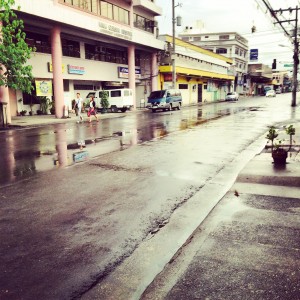(Written – Jan. 7, 2015)
We are really getting into the swing of things. It has been two days since we have been here and I am realizing that it is probably best that I blog everyday so I don’t forget to mention anything important…lets see how much I can keep up. The last two days have been very eventful, Catholic Relief Services (CRS), our host in Mindanao gave us a very warm welcome. We were handed a hefty packet of information that we should know to be better prepared once we are in the field…slightly intimidating but super exciting thinking about the prospects of learning from different people. I really appreciated the overview they gave us because even after having read a good deal on various aspects of the conflict in Mindanao, it was extremely helpful to see how the locals deal with this day in and out.
If you remember from my last post, I had mentioned that I want to explore the displaced peoples in Mindanao, so I will start with covering a topic that CRS and other people we met mentioned that is very interesting in terms of displacement. The indigenous people (IP) of Mindanao are usually left out or not considered an important stakeholder when this conflict is viewed at a macro level. In other words, the IP usually become collateral damage when violence erupts between the rebel groups and the government. According to CRS, IP are first to be recruited by every side and tend to be the first to be injured or even die. That does not however mean that the IP join the fight without a cause, they are fighting for legal rights to land that they claim belonged to them before Muslim and Christians settled into those lands. Ancestral domain is a big issue for IP along with recognition for their way of life. The process to claim land under ancestral domain is difficult and only a handful cases have actually been recognized to be legitimate claims. Another very important reason that IP join the fight is due to poverty, the various rebel groups offer money (a minuscule amount) to take up arms. When you do not have a source of income or any prospects, one can’t afford to be picky about taking up arms or starving. Consequently, IP are joining a fight that is not getting them anything according to a religious leader we met, and still struggling with the legal system to get back what they have already lost. This leads to more IPs being displaced than any other group according to an academic research group we met. They do make use of the temporary displacement camps that NGOs and government agencies set up, however the uncertainty of their home ever being safe is always a question.
I would really like to know more about the patterns of what exactly happens to IP communities after violence erupts, in terms of joining the conflict and taking up arms, casualties, internal displacement camps and reintegration back in to the society. I am looking forward to an IP’s group we are to meet in a few days to learn about the specifics of their plight. That is not to say that the main topic has been the struggle of the IP in the last two days, most of our conversations with the four groups have been centered on the macro-level of the conflict. It is truly amazing how willing everyone is to share information with us and answer any and every question we have. I can see that the entire group is brimming with excitement as we all are tripping over each other to ask the million questions that run through our minds.



